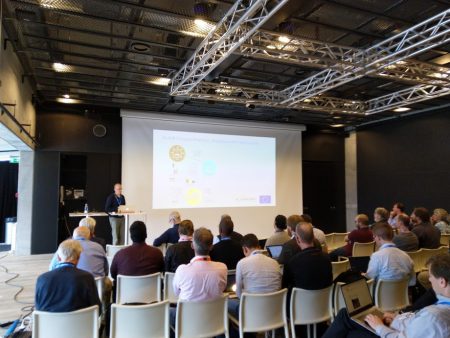Platform9’s Fission Speeds Serverless Test, Dev on Kubernetes
 The platform offers live-reload and record-replay of application code that is the first of its kind for a serverless system.
The platform offers live-reload and record-replay of application code that is the first of its kind for a serverless system.
 The platform offers live-reload and record-replay of application code that is the first of its kind for a serverless system.
The platform offers live-reload and record-replay of application code that is the first of its kind for a serverless system.
 The group, in conjunction with CableLabs, has developed a vRAN reference design that will enable cable companies to launch 4G, and ultimately 5G.
The group, in conjunction with CableLabs, has developed a vRAN reference design that will enable cable companies to launch 4G, and ultimately 5G.
The Datanauts dive into Microsoft's Azure DevOps, a suite of online tools to help developers make DevOps a reality. Our guest and guide is Nathaniel Avery, a solutions architect.
The post Datanauts 149: Entering The DevOps World With Azure DevOps appeared first on Packet Pushers.
 IBM increased its cloud revenue 20 percent during the third quarter of 2018. But overall revenue dropped 2 percent compared to last year.
IBM increased its cloud revenue 20 percent during the third quarter of 2018. But overall revenue dropped 2 percent compared to last year.
 Huawei’s recent AI portfolio release emphasizes that AI isn’t just a collection of fancy machine learning libraries but is instead a facet of a much larger, living system.
Huawei’s recent AI portfolio release emphasizes that AI isn’t just a collection of fancy machine learning libraries but is instead a facet of a much larger, living system.

The 18th Annual Global LambaGrid Workshop (GLIF 2018) was held on 18-21 September 2018 at the Kulturværftet in Helsingør (Elsinore), Denmark. Kronberg Castle, located next to the venue, was immortalised as Elsinore in the William Shakespeare play Hamlet, but there proved to be nothing rotten with the state of high-bandwidth networking as 50 participants from 19 countries came to hear how these networks are facilitating exascale computing in support of biological, medical, physics, energy production and environmental research, and to discuss the latest infrastructure developments.
This event was organised by myself with support from NORDUnet who hosted the event in conjunction with the 30th NORDUnet Conference (NDN18), and where I also took the opportunity to raise awareness of the MANRS initiative.

The keynote was provided by Steven Newhouse (EBI) who presented the ELIXIR Compute Platform which was being used for analysing life science data. In common with high-energy physics, genomics research produces a lot of data, but this is more complex and variable, requires sequencing and imqging on shorter timescales, and of course has privacy issues. The European Molecular Biology Laboratory is based across six countries and employs over 1,600 people, but also collaborates with thousands of other scientists Continue reading


When considering website performance, the term TTFB - time to first byte - crops up regularly. Often we see measurements from cURL and Chrome, and this article will show what timings those tools can produce, including time to first byte, and discuss whether this is the measurement you are really looking for.
cURL is an excellent tool for debugging web requests, and it includes the ability to take timing measurements. Let’s take an example website www.zasag.mn (the Mongolian government), and measure how long a request to its home page takes:
First configure the output format for cURL in ~/.curlrc:
$ cat .curlrc
-w "dnslookup: %{time_namelookup} | connect: %{time_connect} | appconnect: %{time_appconnect} | pretransfer: %{time_pretransfer} | starttransfer: %{time_starttransfer} | total: %{time_total} | size: %{size_download}\n"Now connect to the site dropping the output (-o /dev/null) since we’re only interested in the timing:
$ curl -so /dev/null https://www.zasag.mn
dnslookup: 1.510 | connect: 1.757 | appconnect: 2.256 | pretransfer: 2.259 |
starttransfer: 2.506 | total: 3.001 | size: 53107These timings are in seconds. Depending on your version of cURL, you may Continue reading
The post BGP Labeled Unicast (BGP-LU) appeared first on Noction.
Ever since the “Aurora” vector processor designed by NEC was launched last year, we have been wondering if it might be used as a tool to accelerate workloads other than the traditional HPC simulation and modeling jobs that are based on crunching numbers in single and double precision floating point. …
Hadoop And Spark Get A Vector Performance Boost was written by Timothy Prickett Morgan at .
The industry’s inability to move forward with network automation despite its benefits means it’s time to try a new approach. That approach must focus on people to accelerate the pace of automation adoption.
A team of IPv6 security experts I highly respect (including my good friends Enno Rey, Eric Vyncke and Merike Kaeo) put together a lengthy document describing security considerations for IPv6 networks. The document is a 35-page overview of things you should know about IPv6 security, listing over a hundred relevant RFCs and other references.
No wonder enterprise IPv6 adoption is so slow – we managed to make a total mess.
This post is no way related to Networking ! 
It’s always my fascination to implement a specific tech towards home automation so as to have more time in hands. The first step towards this was to use a Tp-link smart switch which came with Alexa, now problem with that is that Tplink app was not properly responding to Alexa and TP-Link smart switch in itself was costly.
I wanted something low-cost, something which I can experiment yet be cost effective, After some re-search I came across Sonoff-Basic model.
https://sonoff.itead.cc/en/products/sonoff/sonoff-basic
I integrated with Amazon echo but again there were app issues (default app is ewelink), though it was working fine something was missing, I couldn’t tinker it to my wish
I found then there is a open-source version of a similar firmware called TASMOTA and we have to flash this sonoff with the new firm-ware of Tasmota, I have to tell you here there is every possibility you would brick your device and make it useless in the process.
https://github.com/arendst/Sonoff-Tasmota/wiki/Prerequisite
Everything is so well documented, there is no need to re-iterate things here, but just to show case another successful implementation.
Need-less to say you are playing with AC/DC Continue reading
REPT: reverse debugging of failures in deployed software Cui et al., OSDI’18
REPT (‘repeat’) won a best paper award at OSDI’18 this month. It addresses the problem of debugging crashes in production software, when all you have available is a memory dump. In particular, we’re talking about debugging Windows binaries. To effectively understand and fix bugs, a developer wants to be able to follow the path leading up to the point of failure. Not just the control flow, but also the data values involved. This is known as reverse debugging. What’s so clever about REPT is that it enables reverse debugging without the high overheads of record/replay systems (typically up to 200%). It combines low overhead hardware tracing (Intel PT) to record a programs control flow, with a novel binary analysis technique to recover (a very good percentage of) data flow information. Evaluated on 16 real-world bugs in software such as Chrome, Apache, PHP, and Python, REPT enabled effective reverse debugging for 14 of them, including 2 concurrency bugs.
REPTs offline binary analysis and reverse debugging is integrated into WinDbg, and the Windows Error Reporting service (WER) is enhanced to support REPT so that developers can request Intel PT Continue reading